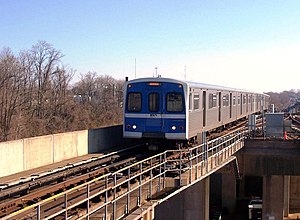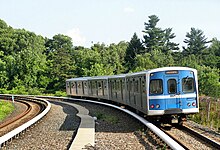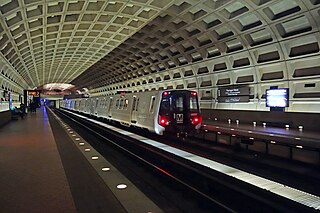
The Washington Metro, often abbreviated as the Metro and formally the Metrorail, is a rapid transit system serving the Washington metropolitan area of the United States. It is administered by the Washington Metropolitan Area Transit Authority (WMATA), which also operates the Metrobus service under the Metro name. Opened in 1976, the network now includes six lines, 98 stations, and 129 miles (208 km) of route.
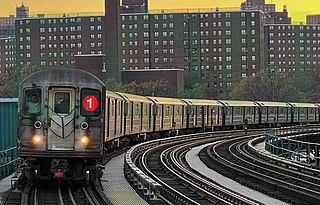
The New York City Subway is a rapid transit system in the New York City boroughs of Manhattan, Brooklyn, Queens, and the Bronx. It is owned by the government of New York City and leased to the New York City Transit Authority, an affiliate agency of the state-run Metropolitan Transportation Authority (MTA). Opened on October 27, 1904, the New York City Subway is one of the world's oldest public transit systems, one of the most-used, and the one with the most stations, with 472 stations in operation.

The Staten Island Railway (SIR) is a rapid transit line in the New York City borough of Staten Island. It is owned by the Staten Island Rapid Transit Operating Authority (SIRTOA), a subsidiary of the Metropolitan Transportation Authority, and operated by the New York City Transit Authority Department of Subways. SIR operates 24 hours a day, seven days a week, providing local service between St. George and Tottenville, along the east side of the island. There is currently only one line on the island, and there is no direct rail link between the SIR and the New York City Subway system, but SIR riders do receive a free transfer to New York City Transit bus and subway lines, and the line is included on official New York City Subway maps. Commuters on the railway typically use the Staten Island Ferry to reach Manhattan. The line is accessible from within the Ferry Terminal, and most of its trains are timed to connect with the ferry. In 2023, the system had a ridership of 6,151,400, or about 19,500 per weekday as of the fourth quarter of 2023.

The Maryland Transit Administration (MTA) is a state-operated mass transit administration in Maryland, and is part of the Maryland Department of Transportation. The MTA operates a comprehensive transit system throughout the Washington-Baltimore metropolitan area. There are 80 bus lines serving the Baltimore Metropolitan Area, along with rail services that include the Light Rail, Metro Subway, and MARC Train. In 2023, the system had a ridership of 52,922,000, or about per weekday as of the fourth quarter of 2023.

The PATCO Speedline, signed in Philadelphia as the Lindenwold Line and also known colloquially as the PATCO High Speed Line, is a rapid transit route operated by the Port Authority Transit Corporation (PATCO), which runs between Philadelphia, Pennsylvania, and Camden County, New Jersey.

MARC is a commuter rail system in the Washington–Baltimore area. MARC is administered by the Maryland Transit Administration (MTA) and operated under contract by Alstom and Amtrak on track owned by CSX Transportation (CSXT) and Amtrak. In 2023, the system had a ridership of 3,860,600, or about 12,400 per weekday as of the fourth quarter of 2023, less than pre-COVID-19 pandemic weekday ridership of 40,000.
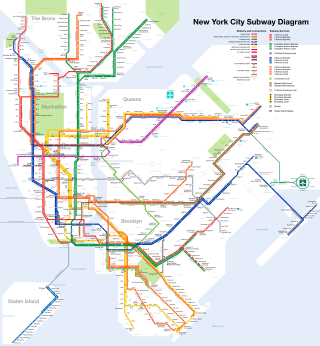
The New York City Subway is a rapid transit system that serves four of the five boroughs of New York City, New York: the Bronx, Brooklyn, Manhattan, and Queens. Its operator is the New York City Transit Authority, which is itself controlled by the Metropolitan Transportation Authority of New York. In 2015, an average of 5.65 million passengers used the system daily, making it the busiest rapid transit system in the United States and the 11th busiest in the world.

Muni Metro is a semi-metro system serving San Francisco, California, United States. Operated by the San Francisco Municipal Railway (Muni), a part of the San Francisco Municipal Transportation Agency (SFMTA), Muni's light rail lines saw an average of 75,500 boardings per day as of the fourth quarter of 2023 and a total of 24,324,600 boardings in 2023, making it the sixth-busiest light rail system in the United States.

The Los Angeles Metro Rail is an urban rail transit system serving Los Angeles County, California in the United States. It consists of six lines: four light rail lines and two rapid transit lines, serving a total of 101 stations. It connects with the Metro Busway bus rapid transit system, the Metrolink commuter rail system, as well as several Amtrak lines. Metro Rail is owned and operated by the Los Angeles County Metropolitan Transportation Authority (Metro).

The B Line is a fully underground 14.7 mi (23.7 km) rapid transit line operating in Los Angeles, running between North Hollywood and Downtown Los Angeles. It is one of six lines in the Los Angeles Metro Rail system, operated by the Los Angeles County Metropolitan Transportation Authority. Built in four stages between 1986 and 2000, the line cost $4.5 billion.
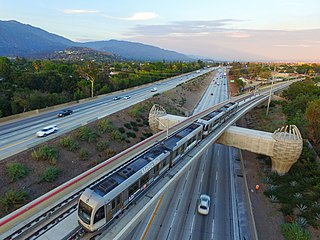
The A Line is a 48.5-mile (78.1 km) light rail line in Los Angeles County, California. It is one of the six lines of the Los Angeles Metro Rail system, operated by the Los Angeles County Metropolitan Transportation Authority (Metro). The A Line serves 44 stations and runs east-west between Azusa and Pasadena, then north-south between Pasadena and Long Beach. It interlines and shares five stations with the E Line in Downtown Los Angeles. Service operates for approximately 19 hours with headways of up to 8 minutes during peak hours. The A Line is currently the longest light rail line in the world.

The Baltimore Light RailLink is a light rail system serving Baltimore, Maryland, United States, and its northern and southern suburbs. It is operated by the Maryland Transit Administration. In downtown Baltimore, it uses city streets. Outside the central portions of the city, the line is built on private rights-of-way, mostly from the defunct Northern Central Railway, Baltimore and Annapolis Railroad and Washington, Baltimore and Annapolis Electric Railway. The system had a ridership of 3,546,300, or about 12,500 per weekday, as of the fourth quarter of 2023.

The D Line is a fully underground 5.1-mile (8.2 km) rapid transit line operating in Los Angeles, running between Koreatown and Downtown Los Angeles. It is one of six lines on the Metro Rail system, operated by the Los Angeles County Metropolitan Transportation Authority.

The M1 and M3 are two similar series of electric multiple unit rail cars built by the Budd Company for the Long Island Rail Road, the Metro-North Railroad and Metro-North's predecessors, Penn Central and Conrail. Originally branded by Budd as Metropolitans, the cars are more popularly known under their model names, M1 and M3. The Metro-North cars were branded under the M1A and M3A series.

The M2, M4 and M6 were three similar series of electric multiple unit rail cars produced by the Budd Company (M2), Tokyu Car Corporation (M4), and Morrison-Knudsen (M6) for the Metropolitan Transportation Authority (MTA) and the Connecticut Department of Transportation (ConnDOT). Initially branded as the Cosmopolitans, the cars were later more popularly known under their model names, M2, M4, M6. They ran on the New Haven Line for most of their service life.

Metrorail is a rapid transit system in Miami and Miami-Dade County in the U.S. state of Florida. Metrorail is operated by Miami-Dade Transit (MDT), a departmental agency of Miami-Dade County. Opened in 1984, it is Florida's only rapid transit metro system, and is currently composed of two lines of 23 stations on 24.4 miles (39.3 km) of standard gauge track. Metrorail serves the urban core of Miami, connecting Miami International Airport, the Health District, Downtown Miami, and Brickell with the northern developed neighborhoods of Hialeah and Medley to the northwest, and to suburban The Roads, Coconut Grove, Coral Gables, and South Miami, ending at urban Dadeland in Kendall. Metrorail connects to the Metromover in Downtown, which provides metro service to the entirety of Downtown and Brickell. Additionally, it connects to South Florida's commuter rail system at Tri-Rail station, as well as Metrobus routes at all stations. In 2023, the system had 13,439,300 rides, and about 48,300 per day in the fourth quarter of 2023.

The Penn Line is a MARC passenger rail service operating between Union Station in Washington, D.C., and Perryville, Maryland, along the far southern leg of the Northeast Corridor; most trains terminate at Baltimore's Penn Station. It is MARC's only electrified line. However, a majority of trips remain diesel powered. With trains operating at speeds of up to 125 miles per hour (201 km/h), it is the fastest commuter rail line in the United States. The service is operated by Amtrak under contract to the Maryland Transit Administration. MARC sets the schedules, owns most of the stations, and controls fares, while Amtrak owns and maintains the right-of-way, supplies employees to operate trains, and maintains the rolling stock. It is the busiest of MARC's three lines, with twice as many trains and ridership as the Brunswick and Camden lines combined.

Mondawmin station is a Metro SubwayLink station in Baltimore, Maryland. It is located under the intersection of Reisterstown Road and Liberty Heights Avenue in the Mondawmin neighborhood, adjacent to the Mondawmin Mall. It is the northernmost underground station on the line, and a major transfer point to many bus routes.

The Massachusetts Bay Transportation Authority (MBTA) operates rapid transit, light rail, and bus rapid transit services in the Boston metropolitan area, collectively referred to as the rapid transit, subway, or the T system.

The Budd Universal Transit Vehicle is an electric multiple unit heavy rail car built for use on the Baltimore Metro SubwayLink and Miami-Dade Metrorail systems. They were built by the Budd Company from 1983 to 1986, and were the last cars ever built by Budd before the company shuttered its railcar manufacturing business.

